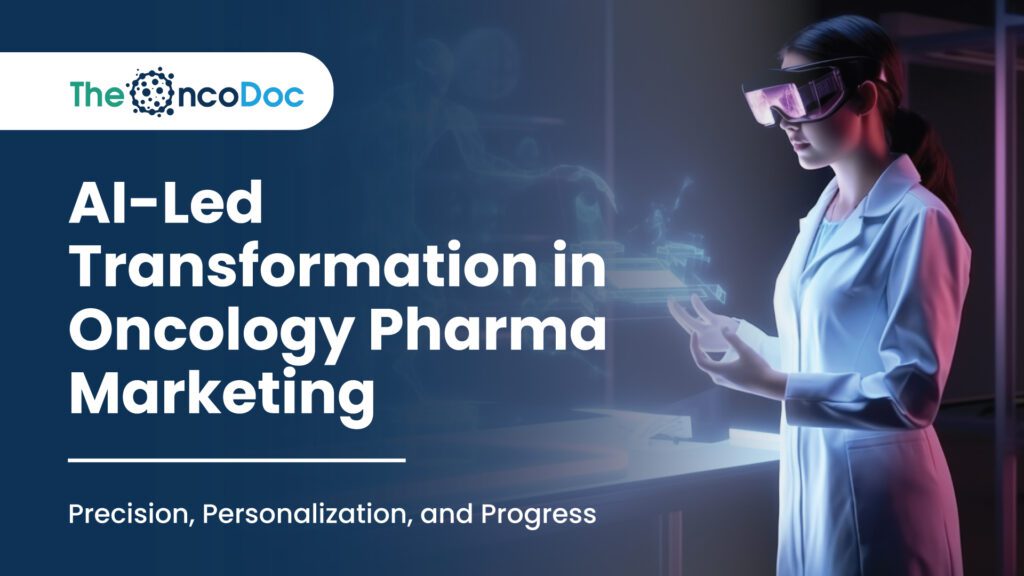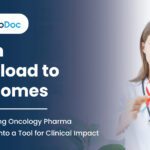Introduction: Oncology’s New Marketing Paradigm
Oncology, long at the forefront of clinical research, now finds itself at the cutting edge of marketing transformation as well. In a world where cancer care becomes increasingly personalized, the methods to reach oncologists, patients, and caregivers must evolve at the same pace. Pharma marketing, traditionally characterized by broad-based promotions and static content, is being disrupted by artificial intelligence (AI). The integration of AI into oncology pharma marketing is not a trend but a tectonic shift, driving precision, predicting behavior, and personalizing engagement at an unprecedented scale.
As cancer becomes more data-defined, with biomarkers, genomics, and clinical real-world evidence, AI becomes essential in understanding not just diseases but also decision-makers. The future of oncology marketing lies not in pushing messages, but in co-creating outcomes with physicians, payers, and patients.
Section 1: The Rise of AI in Pharma Marketing – Why Oncology Leads
AI adoption in pharma marketing is growing rapidly, but oncology is uniquely poised to benefit due to several factors:
- Data-rich ecosystem (EMRs, imaging, molecular profiles)
- Fast-paced innovation (e.g., immunotherapy, CAR-T, targeted therapies)
- Highly specialized physician audiences
- Urgent demand for education around new modalities
A recent industry survey shows that 62% of pharma marketers see oncology as the leading domain for AI-driven campaigns, followed by rare diseases and neurology.
AI allows marketers to break away from conventional segmentation models and instead use predictive analytics, behavioral clustering, and contextual triggers to tailor campaigns. In oncology, where treatment guidelines evolve rapidly, such agility can directly impact prescribing behavior and patient outcomes.
Section 2: From Awareness to Action – AI Across the Funnel
Traditional pharma marketing focuses heavily on top-of-the-funnel awareness. But AI enables smarter engagement across the entire funnel, from awareness to prescription to adherence.
Top-of-Funnel (Awareness):
- NLP-powered social listening detects emerging concerns among oncologists.
- AI curates hyper-targeted content feeds on professional platforms like Hidoc Dr or Medscape.
Mid-Funnel (Consideration):
- Chatbots simulate peer-to-peer conversations.
- Interactive tools (e.g., virtual tumor boards) allow oncologists to explore case-based applications of new drugs.
Bottom-of-Funnel (Action):
- Predictive AI suggests the most likely conversion points and nudges physicians with evidence summaries or KOL videos.
- Reinforcement AI ensures timely reminders for re-prescriptions or follow-up webinars.
Such end-to-end orchestration ensures that AI isn’t just optimizing campaigns, but enhancing care pathways.
Section 3: Personalization at Scale – Redefining HCP Engagement
With over 1.2 million oncologists globally, each with different sub-specialties and practice settings, personalization becomes a necessity, not a luxury.
AI can:
- Analyze HCP behavior across channels (webinars, journal reads, social engagement)
- Profile individual oncologists’ learning styles, preferred formats, and patient demographics
- Deliver modular content tailored to tumor type, practice region, and language
For instance, an oncologist in rural Maharashtra treating head-and-neck cancer patients may receive content in regional language with case studies from similar geographies. A specialist in Tokyo treating HER2-positive breast cancer might receive 3D mechanism-of-action animations via an AR/VR headset.
This level of hyper-personalization drives deeper trust and knowledge retention, while also respecting the oncologist’s time and context.
Section 4: Content Intelligence – From Static to Smart Assets
AI is revolutionizing content itself. Traditional pharma assets like PDFs and brochures are passive; AI-enabled content is dynamic and responsive.
Applications Include:
- Adaptive eDetailers that change based on user inputs
- AI-generated explainer videos localized by culture and language
- Smart dosing calculators embedded in physician dashboards
One powerful use case is Natural Language Processing (NLP) applied to clinical queries. AI can now analyze common search patterns and clinical doubts expressed by oncologists and pre-populate FAQ sections, chatbot scripts, or webinar Q&A content.
Moreover, using sentiment analysis on webinar chat logs and survey responses, pharma teams can recalibrate their messages in near-real time.
Section 5: Precision Targeting – Beyond Demographics
Conventional pharma targeting focused on broad attributes like physician specialty, location, and prescribing history. AI transforms this approach by uncovering deeper, behavior-based insights through psychographics, digital engagement patterns, and unstructured data sources such as EMR notes, search habits, or event participation.
AI-Driven Targeting Examples:
- Oncologists browsing biomarker updates late at night may be best engaged with early morning clinical summaries
- Physicians who attend virtual conferences but skip live events might prefer short, on-demand video content over webinars
- Doctors frequently referencing molecular pathways in glioma could respond better to deep-dive whitepapers than brand overviews
Such micro-segmentation allows pharma marketers to go beyond “who” and understand the “how” and “when” behind engagement. The result is a targeting strategy that aligns not only with the oncologist’s profile but also with their context, preferences, and intent.
This level of precision reduces content fatigue, boosts relevance, and increases the likelihood of meaningful interaction, ensuring that every message is timely, personalized, and valuable in the clinical decision-making journey.
Section 6: Real-World Data (RWD) as a Marketing Asset
Real-world data is no longer just a research tool, it’s a powerful marketing differentiator. AI enables the mining of RWD from EMRs, insurance claims, pathology reports, and patient registries to highlight unmet needs and therapy gaps.
Examples:
- An AI model flags delayed referrals for triple-negative breast cancer in Tier 2 cities
- Claims analysis reveals underuse of second-line therapies in advanced lung cancer
- Patient registry trends show regional disparities in biomarker testing
These insights inform marketing content, outreach strategy, and even sales rep briefing materials.
When AI aligns marketing with real-world oncology challenges, pharma moves from promotion to partnership.
Section 7: Patient-Centric Campaigns Powered by AI
In oncology, patient empowerment is as vital as clinical efficacy. AI enables pharma to craft deeply resonant, patient-first campaigns that go beyond physician engagement and directly support patients and caregivers throughout their journey.
AI-Driven Tactics for Patient Engagement:
- Personalized survivor stories, curated based on tumor type, demographics, and location
- Conversational AI tools, guiding patients through diagnostics, informed consent, or trial enrollment pathways
- Natural Language Processing (NLP) to translate complex medical jargon into clear, culturally relevant language
For instance, an AI-powered lung cancer campaign might mine patient forums to uncover common emotional concerns, such as fear of side effects or stigma, and then tailor educational videos or social ads to address those themes. Similarly, a multilingual chatbot integrated into a regional cancer center could assist caregivers in vernacular languages, providing step-by-step chemotherapy prep guidance.
By turning unstructured patient data into actionable insights, AI helps brands deliver compassionate, relevant, and timely information. This shift not only improves health literacy but fosters greater brand trust and loyalty. Ultimately, patient-centric AI applications ensure oncology marketing contributes meaningfully to better care experiences, not just better reach.
Section 8: Metrics that Matter – From Clicks to Clinical Change
The success of AI-led marketing can’t be measured by vanity metrics like open rates alone. Oncology demands impact-centric KPIs.
Key Metrics:
- Time-on-tool (e.g., average time on AI-driven risk calculators)
- Video share rate by HCPs to their patients
- Webinar questions submitted per participant
- Change in prescribing behavior post-engagement
- AI-predicted vs. actual patient adherence rates
With AI, marketers can create feedback loops, where data from engagement fuels better targeting and message refinement, continuously improving ROI and relevance.
Section 9: Navigating Ethics and Compliance in the AI Era
As AI becomes central to oncology pharma marketing, it brings not just opportunity but also responsibility. The same technologies that enable precision and personalization can, if unchecked, introduce bias, breach privacy, or erode trust. Ethical deployment of AI must therefore be foundational, not optional.
Core Ethical Guidelines for AI in Pharma Marketing:
- Transparency: Clearly explain how and why HCPs are selected or targeted through AI-driven decisions
- Informed Consent: Make patients aware when they are interacting with AI tools like chatbots or recommendation engines
- Bias Control: Rigorously audit data sets to prevent amplification of systemic disparities across geography, ethnicity, or socioeconomic status
- Data Protection: Ensure adherence to global data standards such as HIPAA, GDPR, and local regulatory frameworks
Pharma companies also bear the responsibility of ensuring AI-generated content remains clinically accurate and on-label. Even subtle misinterpretations or unreviewed outputs could lead to misinformation or regulatory violations.
To manage these risks, compliance teams are evolving into AI governance boards, comprising medical, legal, data science, and marketing leaders. These bodies review training data, algorithm logic, and campaign outcomes, ensuring ethical integrity at every stage.
In oncology, where patient vulnerability is high and treatment decisions are complex, ethical AI use isn’t just about compliance, it’s about compassion, safety, and sustaining long-term trust. A principled approach today lays the groundwork for scalable, responsible innovation tomorrow.
Section 10: Building Internal AI Fluency – Teams, Tools, and Training
To truly harness the potential of AI in oncology pharma marketing, organizations must go beyond technology adoption, they must cultivate internal AI fluency across all functions. It’s not solely the responsibility of data scientists; success depends on enabling brand, medical, commercial, and creative teams to think, plan, and execute with AI in mind.
Key Organizational Priorities:
- Upskill brand teams in AI fundamentals, including prompt design, model behavior, and data ethics
- Deploy AI-driven content assistants to accelerate the creation of compliant, personalized messaging
- Empower MSLs with AI dashboards that synthesize HCP behavior, content preferences, and local trends
- Embed AI tools within CRM platforms to recommend next-best actions, timing, and channels for engagement
These steps ensure AI becomes part of everyday workflows, not a siloed function. The goal is not just faster execution, but smarter, evidence-informed decisions at every level of campaign planning and delivery.
Forward-thinking pharma players like AstraZeneca, Novartis, and Roche are investing in internal AI centers of excellence. These teams act as rapid-response squads, testing micro-campaigns, optimizing messages in real time, and creating agile feedback loops between marketing and medical affairs.
In oncology, where speed and precision are vital, AI fluency is a competitive advantage. Companies that invest in internal capabilities today will be better equipped to lead tomorrow’s intelligent, adaptive, and outcome-focused marketing landscape.
Section 11: Future-Proofing Oncology Pharma Marketing
The oncology brand of tomorrow will transcend the boundaries of conventional pharmaceutical identity. It won’t be defined solely by molecules or mechanisms, but by the ecosystem it builds around clinicians, patients, and data. Artificial Intelligence (AI) is the catalyst enabling this paradigm shift, transforming marketing from message-pushing to value-creation.
The Oncology Brand of the Future Must:
- Provide solutions, not slogans (e.g., AI-enabled diagnostic support tools, treatment simulators)
- Support the care team, not just the prescriber (e.g., resources for multi-disciplinary tumor boards)
- Drive measurable improvements, not just visibility (e.g., reducing treatment initiation time through predictive triage)
- Elevate patient participation, not just awareness (e.g., AI-led navigators guiding patients through their care journey)
This new model positions pharma companies not as advertisers, but as clinical partners, equipping the ecosystem with intelligent tools that solve real-world oncology challenges. The infusion of AI means that marketing strategies can now dynamically adapt to clinical changes, practice settings, and patient needs in real time.
AI does not aim to replace the empathy, nuance, or clinical judgment of human interaction. Instead, it enhances these elements, scaling expertise, speeding access, and supporting decisions where it matters most. In oncology, where timelines are tight and stakes are high, this evolution is not optional, it’s essential.
Future-ready oncology brands will be defined not by their promotional reach, but by the precision, relevance, and humanity of their AI-powered interventions.
Conclusion: From Algorithms to Advocacy
AI in oncology pharma marketing is not a technological upgrade, it’s a strategic revolution. It redefines how we understand our audiences, how we craft our messages, and how we measure success. By aligning AI capabilities with the unique demands of cancer care, pharma marketers can evolve from brand custodians to change agents.
In this journey, the ultimate winners are not just companies, but patients, who receive better information, faster access, and more personalized care because of smarter marketing.
As AI continues to learn and evolve, so must we, adopting it with wisdom, deploying it with integrity, and using it to heal, not just to sell.
The Oncodoc team is a group of passionate healthcare and marketing professionals dedicated to delivering accurate, engaging, and impactful content. With expertise across medical research, digital strategy, and clinical communication, the team focuses on empowering healthcare professionals and patients alike. Through evidence-based insights and innovative storytelling, Hidoc aims to bridge the gap between medicine and digital engagement, promoting wellness and informed decision-making.



